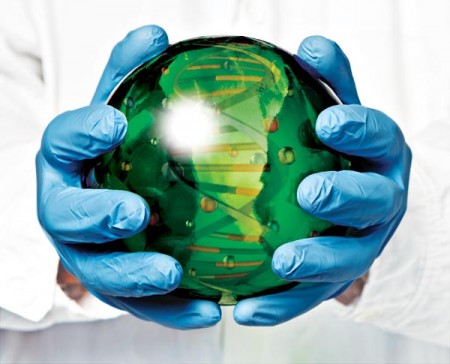December 6, 2015 – Back in 2012 I wrote a posting entitled “If the Climate Changes Wouldn’t it be Easier to Change Us?” It seemed bizarrely logical that since we were altering the global environment through technology why not alter ourselves to thrive in these changing circumstances. In the article I referred to Margaret Atwood’s novel, Oryx and Crake, where genetically re-engineered humans become part of a scheme to rid the planet of our species to save it. These evolved Atwood humans are smaller, vegetarian, programmed to be social and non-aggressive, and to reproduce less, in other words in homeostasis with a future environment that very much fits with global warming scenarios.
As bizarre as the notion is to re-engineer us, there are researchers today speculating on creating synthetic life to help us get out of our current global warming bind. One of these is Ricard Solé, a professor at ICREA-Complex Systems Lab in Barcelona, Spain, who has speculated that by engineering synthetic organisms we may create the means of restoring ecological homeostasis on our planet. This would come through the creation of artificial life or lives capable of reproducing either on a regional or global scale. Multiple artificial life forms could address all geographic and ecological domains on the planet. Design would take into consideration the impact of the synthetic biology on all other living things and ensure that no synthetic transference enters into natural biological systems. It could involve creating symbiotic relationships between artificial life and biological life which could act as host. Synthetic life might even be designed to live and flourish in detritus we humans produce like the plastic debris floating in the ocean, or in raw sewage or landfill, breaking down pollutants, capturing carbon dioxide and providing other benefits.
At ICREA there is ongoing research into synthetic biology looking at multicellularity, collective intelligence (think the intelligence of a swarm as demonstrated by bees, army ants and even schools of fish evading predators) and organogenesis (substituting bio-engineered tissues in place of living normal or damaged tissues).
How close is ICREA to producing synthetic life?
Right now it more theory and mathematics than reality. But Professor Solé describes the potential of artificial life forms to help us to cut carbon emissions, reforest our planet, turn wasteland into arable farmland, and even end freshwater shortages. He argues that synthetic biology could terraform Earth in human timescales, not geological ones, and that genetically manipulated organisms could be designed to be self-limiting so there would be no unintended consequences.
Solé describes several scenarios:
-
creating life that would work on a small or regional scale addressing specific types of contaminated terrain or degraded semiarid land.
- creating life designed to rapidly achieve global reach to reduce greenhouse gases or nitrogen excess, or sequester carbon through artificial photosynthesis.
- engineering life to accelerate plant root development enhancing crop yields, or interacting with soil bacteria and plants to optimize moisture retention and reduce erosion.
In these scenarios bio safety would be a major concern and probably be the largest obstacle to adoption. As I read Solé’s paper one particular scenario came to mind. In Michael Crichton’s novel, Prey, he describes genetically engineered nanotechnology that escapes from its laboratory confines, replicates and develops collective intelligence through swarm behavior. In the end the swarm takes over.
Solé, unlike Crichton, presents the potential beneficial impacts of engineering what he describes as self-limiting biological technology. He sees other uses including synthetic biology to create new drugs and therapies, and to produce bio fuels with zero emissions. I can even think of one use of synthetic biology not mentioned by Solé, the creation of biology-based computing, no longer bound by silicon’s limitations. This is the stuff of Star Trek.
Solé argues that unless we slow our impact on the biosphere we have no safe way out from the Anthropocene we are creating. He concludes: “We cannot foresee all future changes that will unfold in the next decades as a consequence of our impact. What we do know is that all sorts of evidence point towards an unsustainable outcome where our society is likely to fail unless serious measures are taken. Novel approaches are needed, and often the novelty emerges at the crossroads between apparently distant fields. Nowadays, synthetic biology and ecological theory are loosely connected, but it is at the intersection between these two major disciplines where some solutions might reside. The essential message is that we need to reinvent a small part of nature in order to preserve as much as possible while we guarantee our persistence as a species in a sustainable way.”
















